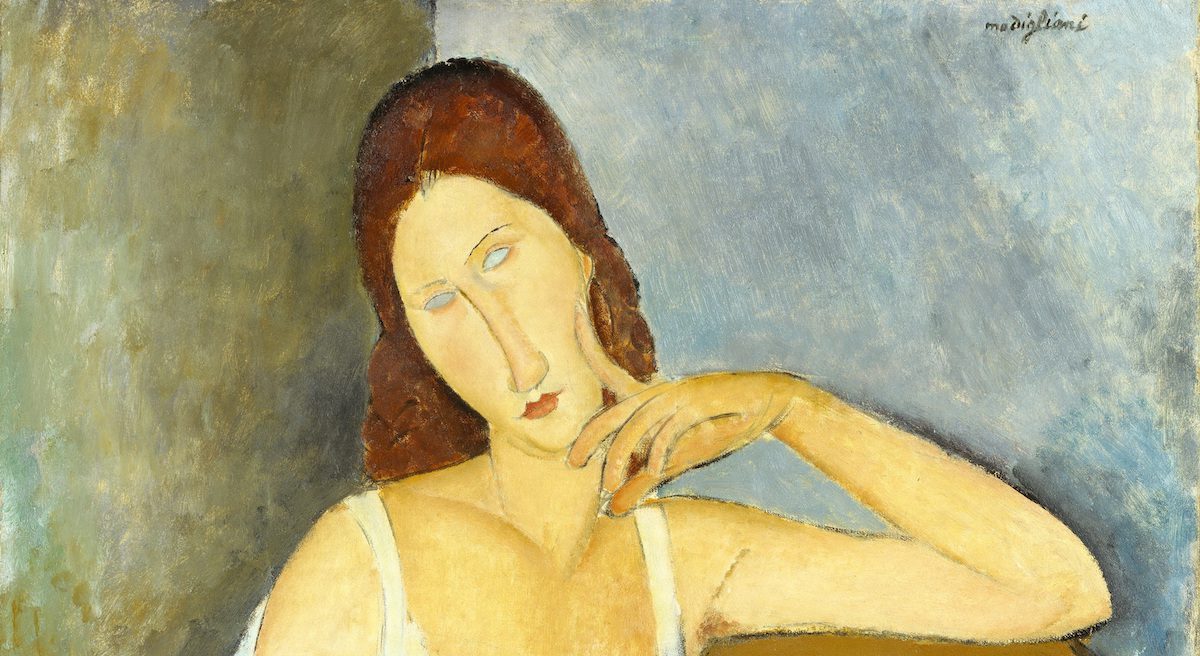Some of Modigliani’s best known and most provocative nudes are to be reunited in London nearly 100 years after they were banned in Paris. It will be a major highlight of a new comprehensive survey of Modigliani at Tate Modern. In these striking canvases, the artist invented shocking new compositions that modernised figurative painting. His explicit depictions of nudes also proved controversial and led to the police censoring his only solo lifetime exhibition, at Berthe Weill’s gallery in 1917, on the grounds of indecency. This group of 10 nudes will be the largest group ever seen in the UK, with paintings including Seated Nude 1917 (Royal Museum of Fine Arts, Antwerp) and Reclining Nude c.1919 (Museum of Modern Art, New York).
Including almost 100 works, the exhibition will re-evaluate this familiar figure
Tate Modern in November 2017 will bring together a dazzling range of his iconic portraits, nudes, sculptures in the largest exhibition to be shown in this country. Although he died tragically young, Amedeo Modigliani (1884–1920) was a ground-breaking artist who pushed the boundaries of the art of his time. Including almost 100 works, the exhibition will re-evaluate this familiar figure, looking afresh at the experimentation that shaped his career and made Modigliani one of the greatest artists of the twentieth century.

Born in Livorno, Italy and working in Paris from 1906, Modigliani’s career was one of continual evolution. The exhibition begins with the artist’s arrival in Paris, exploring the creative environments and elements of popular culture that were central to his life and work. Inspired by the art of Paul Cézanne, Henri Toulouse-Lautrec, and Pablo Picasso, Modigliani began to experiment and develop his own distinctive visual language, seen in early canvases such as Bust of a Young Woman 1908 (Lille Métropole Musée d’Art Moderne, Villeneuve-d’Ascq) and The Beggar of Leghorn 1909 (Private Collection). His circle included poets, dealers, writers, and musicians, many of whom posed for his portraits including Diego Rivera 1914 (Kunstsammlung Nordrhein-Westfalen, Düsseldorf), Juan Gris 1915 (Metropolitan Museum of Art, New York) and Jean Cocteau 1916 (The Henry and Rose Pearlman Foundation, Princeton University Art Museum). The exhibition will also reconsider the role of women in Modigliani’s practice, particularly poet and writer Beatrice Hastings. Hastings will be shown not simply as the artist’s muse, but as an important figure in the cultural landscape of the time.
Modigliani will feature exceptional examples of the artist’s lesser-known work in sculpture, bringing together a substantial group of his Heads made before the First World War. Although the artist’s ill-health and poverty eventually dictated otherwise, he spent a short but intense period focusing on carving, influenced by contemporaries and friends including Constantin Brâncuși and Jacob Epstein. For his wellbeing, Modigliani left Paris in 1918 for an extended period in the South of France. Here he adopted a more Mediterranean colour palette and, instead of his usual metropolitan sitters, he began painting local peasants and children such as Young Woman of the People 1918 (Los Angeles County Museum of Art) and Boy with a Blue Jacket 1919 (Indianapolis Museum of Art).

The exhibition will conclude with some of Modigliani’s best-known depictions of his closest circle. Friends and lovers provided him with much-needed financial and emotional support during his turbulent life while also serving as models. These included his dealer and close friend Léopold Zborowski and his companion Hanka, and Jeanne Hébuterne, the mother of Modigliani’s child and one of the most important women in his life. When Modigliani died in 1920 from tubercular meningitis, Jeanne tragically committed suicide. Tate Modern will bring together several searching portraits of her from Modigliani’s final years, on loan from international collections such as the Philadelphia Museum of Art and Metropolitan Museum of Art, New York, which depict her in a range of guises from a young girl to mother.
Tate and HTC VIVE have also announced a new partnership for Tate Modern’s exhibition, Modigliani. Visitors to the gallery will be able to enjoy a new integrated virtual reality experience right in the heart of the exhibition, the first of its kind at Tate, vividly enhancing our understanding of one of the early twentieth century’s greatest artists.
As part of the most comprehensive exhibition of Modigliani’s work ever held in the UK, the virtual reality room will bring visitors closer to the artist’s world, enriching their understanding of his life and art. Headsets from the leading VR platform Vive will provide an immersive layer of interpretation as visitors are invited to step into early twentieth century Paris. Drawing on archival material and new research, the experience recreates aspects of Modigliani’s adopted city, bringing his historical context to life.
The city of Paris was vital to Modigliani and his move there in 1906 from Italy transformed his work. It introduced him to an important new artistic community that included Pablo Picasso and Jean Cocteau. The exhibition will explore the creative environments and elements of popular culture in Paris which were central to Modigliani’s art, with Vive’s VR technology adding a fresh interpretive dimension. BAFTA-award winning studio Preloaded will be developing the virtual reality experience.
MODIGLIANI Tate Modern 23 November 2017 – 2 April 2018 Adult £18.50 (without donation £16.80). Concession £16.50 (without donation £15)

